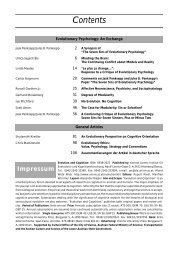Contents - Konrad Lorenz Institute
Contents - Konrad Lorenz Institute
Contents - Konrad Lorenz Institute
You also want an ePaper? Increase the reach of your titles
YUMPU automatically turns print PDFs into web optimized ePapers that Google loves.
Vertical and Horizontal Learning<br />
might imply focus on the pavements of Champs Élyseés<br />
and general weather conditions of Paris, while<br />
historical events and memorials are ignored.<br />
What is true, however, of explicit learning is detachment<br />
from context understood as either condensation<br />
of reality to, (a) variables of one’s choice<br />
or (b) simplification of parameters in learning situation<br />
by idealisation 4 .<br />
Why is that Firstly, processing of symbolically<br />
represented knowledge (that is knowledge that can<br />
be mentally manipulated) is restricted. The number<br />
of elements that can possibly be stored in shortterm<br />
memory (working memory) seems limited. For<br />
instance, it is possible to retain only 3–4 colours or<br />
orientations in visual working memory at a time<br />
(VOGEL/WOODMAN/LUCK 2001). Limitations also exert<br />
themselves in the number of digits in telephone<br />
numbers one can hold in memory (SQUIRE/KANDEL<br />
1999). In practice the actual number of variables relevant<br />
to any given learning situation is constrained<br />
by this limited capacity. Thus keeping in mind certain<br />
features at the expense of others is inevitable<br />
(see also DREYFUS/DREYFUS 1986, 1998). Accentuating<br />
certain parameters takes place at the expense of<br />
an infinite number of potential relevant parameters.<br />
Crudely put the production of knowledge simultaneously<br />
results in the production of non-knowledge<br />
(HOFFMEYER 1984).<br />
Secondly, the very interpretive process of abstract<br />
thought fragments real life entities into nonexistent<br />
pieces of thought, which are mentally manageable<br />
but lack one-to-one correspondence to actual referents.<br />
To exemplify; when speaking of ‘Granny<br />
Smith’ as a type of green apple, one determines all<br />
Granny Smith apples as green. Naturally, this seems<br />
trivial. But if one scrutinises apple skins, the use of<br />
the notion ‘green’ seems unjustified. The actual colour<br />
of Grannies might change from apple to apple,<br />
might be a mixture of a large variety of colours that<br />
exist exclusively in conjunction with the angle of<br />
observation, the light intensity and the viewing distance.<br />
Postulates about the colour of apple skins<br />
ease the burden of communication, but ‘green<br />
Grannies’ as a notion, i.e., abstracted from actual<br />
apples understood as a single colour, easily disclosed<br />
by scrutiny, do not exist in reality. By denoting, for<br />
example, the colour green, verbal (or symbolic)<br />
identification demarcates referents in the world that<br />
do not actually exist detached from context. If Martians,<br />
that neither defecated nor ate were to visit<br />
Earth (as described by DAWKINS 1998) and see apples<br />
for the first time they would probably not respond<br />
to the same features as we do. Perhaps they would<br />
even question whether apples were separate from<br />
branches or leaves, for the simple reason that they<br />
were indifferent to the consequences of such information,<br />
i.e., being non-eaters.<br />
Some might hold that the example about the colour<br />
of apple skins is misleading, since, this argument<br />
might hold with respect to ‘green’ but not<br />
with respect to natural kinds such as gold and tigers.<br />
However, one can rebut the objection by the claim<br />
that definitions of gold and tigers still imply an accentuation<br />
of certain criteria at the expense of others.<br />
By convention we apply criteria and thereby denote<br />
gold or tiger (KURODA 1998). By stressing<br />
certain features (for instance greenness) of apples<br />
the notion of apple is detached from the context in<br />
which any apple actually appears. As such, symbol<br />
use virtually constructs reality in a radical way.<br />
While condensation of reality in the sense of reduction<br />
of numbers of variables might principally<br />
be overcome by improved cognitive abilities such as<br />
increased memory span (COLLINS 2001), detachment<br />
of context by simplification seems insurmountable.<br />
To fully comprehend the implications<br />
of creating cognitive schemas for objects think of<br />
the familiar table. Normally, we encounter no difficulty<br />
in defining where the table begins or ends although<br />
molecularly speaking (at the micro level)<br />
‘ending’ and ‘beginning’ is meaningless. Incessant<br />
exchanges of molecules blur the boundaries between<br />
table and space. After all, it is meaningful to<br />
presuppose the existence of ending and beginning<br />
of tables simply because human perception operates<br />
at the macro level (at which Newton’s laws take effect)<br />
(LAKOFF 1990).<br />
Implicit Learning and<br />
Condensation of Reality<br />
So far I have claimed that explicit learning is subordinate<br />
to (or is characterised by) detachment of context<br />
by 1) reducing the number of variables in a<br />
given learning situation due to perspective taking<br />
and 2) accentuating certain features of the variables<br />
and ignoring others. How does the question of detachment<br />
from context relate to implicit learning<br />
Of interest is whether implicit learning, by being<br />
responsive to relations between many parameters<br />
without involving awareness, avoids contextual<br />
detachment. My answer is no. But implicit learning<br />
is significantly less detached from reality by<br />
there simply being less interpretation, a crucial distinction<br />
when separating explicit from implicit<br />
learning.<br />
Evolution and Cognition ❘ 173 ❘ 2003, Vol. 9, No. 2








